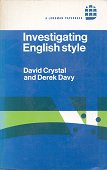
Popular interest and the evident importance of language as the principal means of communication between people, interests, creeds and nations have promoted linguistics, largely in this century, from an amateur study to a widespread academic discipline.
David Crystal shows here what the benefits, as well as the problems, are in studying language in a scientific way. He places modern linguistics in historical perspective and traces in the present century six ‘ages’ in its development, each with its dominant, and abiding, theme. His central chapter discusses, one by one, phonetics, phonology, morphology, ‘surface’ syntax, ‘deep’ syntax, and lastly semantics.
Professor Crystal’s book makes a novel and lively introduction to a significant subject which today concerns not only psychologists, sociologists and philosophers, but teachers, interpreters and even telephone companies.
Any list can only begin to convey the enormous diversity, complexity, and intrinsic fascination of the human faculty of language which is celebrated in The Cambridge Encyclopedia of Language. Carefully developed to present an exceptionally wide range of information in a lively, readable and visually exciting way, it provides the general reader with a succinct, thematic account of language variety, history, structure, and behaviour. Above all it responds to the everyday questions that arise when, for example, teachers face multilingual classrooms, parents listen to their children beginning to talk or read, or professionals consider the practical applications of linguistic research. At the same time the encyclopedia reflects a deeper level of interest, arising out of the researcher’s attempt to find patterns and principles in what we observe; the neurolinguist’s study of the brain’s functions; the speech scientist’s investigation of speech and hearing mechanisms; or the linguist’s comparative study of the languages of the world, whether spoken by hundreds or by millions.
David Crystal’s departure from conventional alphabetical principles has meant that the major Parts of the encyclopedia are organized in the most logical and natural way and the text written throughout in his easy and accessible style. Nevertheless, the Glossary (of over 1000 terms), the Table of the world’s languages, and the substantial indexes included in the Appendices, as well as meticulous cross-referencing throughout the work, ensure that this will be an authoritative source of reference for all readers with an interest in language, languages, and language-related matters.
Crystal gives a whistle-stop overview of the texting phenomenon, doing the usual linguistic thing of saying, no, really, this new phenomenon isn’t destroying language/literacy/life as we know it. It turns out that, rather than an entire generation growing up without vowels, in fact only a minority of texters use “text speak”, and then only in texts, and not in their homework or academic essays.
He gives some historical background, and also some interesting examples of the same kind of “punning” (or possibly gr8ing) text speak occuring in other languages. Part of the problem is getting hold of a big enough corpus of data to do proper analysis; strangely people don’t want to turn over their text records to academics!
Despite only being 5 years old, this is already somewhat outdated, as it is pre smart-phone, assuming the texting is done with a numeric keypad. However, it’s a quick, light read, with some interesting observations.
The answers to all these questions lie deep in the history of our language. Foremost linguistics expert David Crystal unravels a story that begins with an obscure Germanic dialect and ends with a global language – via lazy medieval monks, French and Latin upstarts, American independence, Shakespeare and the Internet.
Armed with the history and the principles revealed within, the curious and confused alike can master the baffling complexities of English spelling – and understand why these peculiarities entered the language in the first place.
English spelling has a reputation for being difficult and arbitrary. Here, Crystal explains why it is the way it is, and attempts to show that such an understanding can make the task of spelling more straightforward, if not exactly easy.
He takes an historical perspective, starting with Latin-speaking 6th century scholars attempting to fit some of the weirder consonants (thorn, eth, yogh, and more), and multiple vowels, of Old English into the too-small Latin alphabet. They each had their own ideas, and multiple different styles got frozen in. Then there were pronunciation changes. Then there was the Great Vowel Shift. Then there were loan words from other languages. Then there were later scholars attempting to retrofit Latin spelling onto English. And so on.
With all that going on, it’s not surprising that the spelling seems a mess. But Crystal’s analysis shows up rather more regularities than might be apparent on a first look. Whether teaching this history would make learning to spell easier, I don’t know. But it certainly makes for a fascinating and informative read.
In this book, David Crystal explores the intriguing story of this verb over 26 chapters, each linked to a particular usage. Chapters explore, for instance, circumstantial be (‘how are you?’), numerical be (‘two and two is four’), quotative be (‘so I was, like, “wow”’). and ludic be (‘oh no he isn’t’). The discussion is accompanied by examples from a whole host of sources, literary and otherwise, such as Beowulf, Jane Austen, pantomime, and Star Wars, and further illustrated by cartoons including several from late nineteenth- and early twentieth-century issues of Punch. Full of fascinating nuggets of information, this book will appeal to a broad audience of language lovers and wordsmiths.